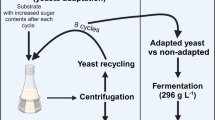Abstract
The cell culture ofAngelica gigas Nakai producing decursin derivatives and immunostimulating polysaccharides was preserved in liquid nitrogen after pre-freezing in a deep freezer at −70°C for 480 min. The effects of the cryoprotectant and pretreatment before cooling were investigated to obtain the optimal procedure for cyropreservation. When compared to mannitol, sorbitol, or NaCl with a similar osmotic pressure, 0.7M sucrose was found to be the best osmoticum for the cryopreservation ofA. gigias cells. In the pre-culture medium, the cells in the exponential growth phase showed the best post-freezing survival after cryopre-servation. A mixture of sucrose, glycerol, and DMSO was found to be an effective cryoprotectant and a higher concentration of the cryoprotectant provided better cell viability. When compared with the vitrification, the optimum cryopreservation method proposed in this study would seem to be more effective for the long-term storage of suspension cells. The highest relative cell viability established with the optimal procedure was 89%.
Similar content being viewed by others
References
Kartha, K. K. (1987) Cryopreservation of secondary metabolite-producing plant cell cultures. pp. 217–227. In: I. K. Vasil (ed.)Cell Culture and Somatic Cell Genetics of Plants. Vol. 4, Academic Press, Orlando, Florida, USA.
Chen, T. H. H., K. K. Kartha, N. L. Leung, W. G. W. Kurz, K. B. Chatson, and F. Consrabel (1984) Cryopreservation of alkaloid-producing cell cultures of Periwinkle (Cathranthus roscus).Plant Physiol. 75: 726–731.
Hitmi, A., H. Sallanon, and C. Barthomeuf (1997) Cryopreservation ofChrysanthemum cinerariacfolium vis. cells and its impact on their pyrethrin biosynthesis ability.Plant Cell Rep. 17: 60–64.
Jain, S., R. K. Jain, and R. Wu (1996) A simple and efficient procedure for cryopreservation of embryogenic cells of aromatic Indica rice varieties.Plant Cell Rep. 15: 712–717.
Dietrich, B., A. S. Popov, B. Pfeiffer, D. Neumann, R. Butenko, and M. Luckner (1982) Cryopreservation ofDigitalis lanata cell cultures.Planta Med. 46: 82–87.
Ahn, K.-S. (1996)A Study on the Anticancer and Immunostimulating Agents from the Root of Angelica gigasNakai. Ph. D. Thesis, Korea University, Seoul, Korea.
Ahn, K.-S., W. S. Sim, and I.-H. Kim (1996) Decursin: A cytotoxic agent and protein kinase C activator from the root ofAngelica gigas.Planta Med. 62: 7–9.
Ahn, K.-S., W. S. Sim, H. M. Kim, S. B. Han, and I.-H. Kim (1998) Immunostimulating polysaccharide from cell culture ofAngelica gigas Nakai.Biotechnol. Lett. 20: 5–7.
Steponkus, P. L. and F. O. Lanphear (1967) Refinement of the triphenyl tetrazolium chloride method of determining cold injury.Plant Physiol. 42: 1423–1426.
Ishikawa, M., P. Tandon, M. Suzuki, and A. Yamaguishi-Ciampi (1996) Cryopreservation of bromegrass (Bromus intermis Leyss) suspension cultured cells using slow prefreezing and vitrification procedures.Plant Sci. 120: 81–88.
Chen, T. H. H., K. K. Kartha, F. Constabel, and L. V. Gusta (1984) Freezing characteristics of culturedCatharanthus roscus (L). G. Don cells treated with dimethylsulfoxide and sorbitol in relation to cryopreservation.Plant Physiol. 75: 720–725.
Ribeiro, R. C. S., Z. Jekkel, B. J. Mulligan, E. C. Cocking, J. B. Power, M. R. Davey, and P. T. Lynch (1996) Regeneration of fertile plants from cryopreserved cell suspensions ofArabidopsis thaliana (L.) Heynh.Plant Sci. 115: 115–121.
Seitz, U., A. W. Alfermann, and E. Reinhard (1983) Stability of biotransformation capacity inDigitalis lanata cell cultures after cryogenic storage.Plant Cell Rep. 2: 273–276.
Panis, B., N. Totte, K. van Nimmen, L. A. Withers, and R. Swennen (1996) Cryopreservation of banana (Musa spp) meristem cultures after preculture on sucrose.Plant Sci. 121: 95–106.
Hirata, K., S. Goda, M. Phunchindawan, D. Du, M. Isuio, A. Sakai, and K. Miyamoto (1998) Cryopreservation of horseradish hairy root cultures by encapsulation-dehydration.J. Ferment. Bioeng. 4: 418–420.
Towill, L. E. (1990) Cryopreservation of isolated mint shoot tips by vitrification.Plant Cell Rep. 9: 178–180.
Author information
Authors and Affiliations
Corresponding author
Rights and permissions
About this article
Cite this article
Cho, JS., Chun, SH., Lee, SJ. et al. Development of cell line preservation method for research and industry producing useful metabolites by plant cell culture. Biotechnol. Bioprocess Eng. 5, 372–378 (2000). https://doi.org/10.1007/BF02942215
Received:
Accepted:
Issue Date:
DOI: https://doi.org/10.1007/BF02942215




